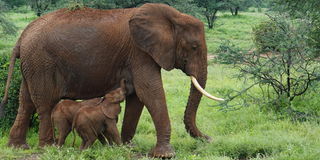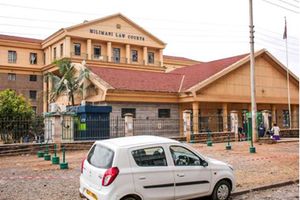Premium
Samburu National Reserve roars back to life after years of poaching, encroachment

Mother elephant by the name Alto with her female twin calves at Samburu National Reserve.
What you need to know:
- Governor Lelelit highlighted his administration’s dedication to conservation efforts within Samburu, which he believes have contributed to the reserve’s renewed appeal.
- "The popularity of the Samburu National Reserve has increased. The animals are back, happier, and roaming all over," said Governor Lelelit.
After years of grappling with relentless poaching, creeping encroachment, and a troubling dip in visitor numbers, Samburu National Reserve is finally reclaiming its glory marked by thriving wildlife and a surge in tourists.
Once on the brink of losing its allure, the park measuring 165 square kilometres is experiencing a wildlife bounce-back and landscape restoration, and tourists are once again eager to experience its untamed beauty.
This comeback is not only a win for conservationists, but also a lifeline for the communities that depend on the park for livelihoods.
The reserve’s revitalisation comes just in time for the Maa Cultural Festival, a four-day celebration to be attended by President William Ruto, that started on Wednesday and ends on Saturday. The event aims to boost tourism across the Maa-speaking counties of Narok, Samburu, and Kajiado.
Years of neglect and challenges had taken a toll on the reserve, causing a steep drop in revenue. However, the Samburu County government along with key players in the tourism sector initiated multiple restoration efforts to rejuvenate the area.
Sambur Governor Lati Lelelit on Wednesday said the county administration has in recent years partnered with conservation groups and Kenya Wildlife Service boosted anti-poaching efforts by increasing patrols, improving surveillance, and collaborating with law enforcement to secure wildlife.
New revenue systems
This also included training and equipping local rangers to better protect endangered species within the reserve.
Roads and pathways within the reserve were improved, and visitor facilities such as lodges, camps, and viewing points were renovated to attract more tourists.
New revenue systems were also introduced to streamline park entry fees, making it easier for tourists to access the park.
The county also strategically introduced the Maa Cultural Festival, which celebrates the cultural heritage of the Maa-speaking communities (Samburu, Maasai, and others).
By combining cultural experiences with wildlife tourism, Samburu aimed to attract a diverse group of visitors and expand tourism appeal, ultimately boosting local tourism.
Today, the reserve is bustling with life as tourists flock to Samburu East to experience not only the festival, but also the park’s unique wildlife including rare species such as the Grevy's zebra and Somali ostrich.
The park’s resurgence has become a substantial revenue source for the county administration. According to the Controller of Budget report, Samburu County achieved 104.1 percent of its annual revenue target in the 2023/24 financial year, generating a total of Sh267 million.
Big Five
This increase was largely attributed to a rise in tourist visits.
"The growth of revenue collection can be attributed to the relatively improved tourist visits that have contributed a more significant share of the county’s source revenue over the years," states the COB report by Dr Margaret Nyakang’o.
She also acknowledged Samburu’s strides in revenue collection, which she credited to a new, streamlined revenue system. The new system, she explained, has enhanced efficiency and encouraged the county to revive dormant revenue streams.
"The increase in revenue can be attributed to the adoption of a new revenue system and the focus of the county government on dormant revenue streams," reads the report.
Located in Samburu East, the Reserve is renowned for its biodiversity.
Besides the iconic Big Five, it is home to a range of unique species such as the Beisa oryx and the reticulated giraffe.
Recently, the reserve made international headlines with a rare natural event, the birth of elephant twins.
In January 2022, a wild elephant gave birth to twin calves, marking the first time since 2006 that such an event was recorded in the reserve.
In November 2023, another elephant gave birth to twin calves, a second historic occurrence within 22 months.
Scientists from Save the Elephants, a research and protection organiSation, documented these rare events drawing significant attention to the reserve.
Governor Lelelit highlighted his administration’s dedication to conservation efforts within Samburu, which he believes have contributed to the reserve’s renewed appeal.
"The popularity of the Samburu National Reserve has increased. The animals are back, happier, and roaming all over," said Governor Lelelit.
As the Maa Cultural Festival kicks off there’s renewed hope that the park’s new status will continue to uplift the local economy and contribute to sustainable conservation efforts.





